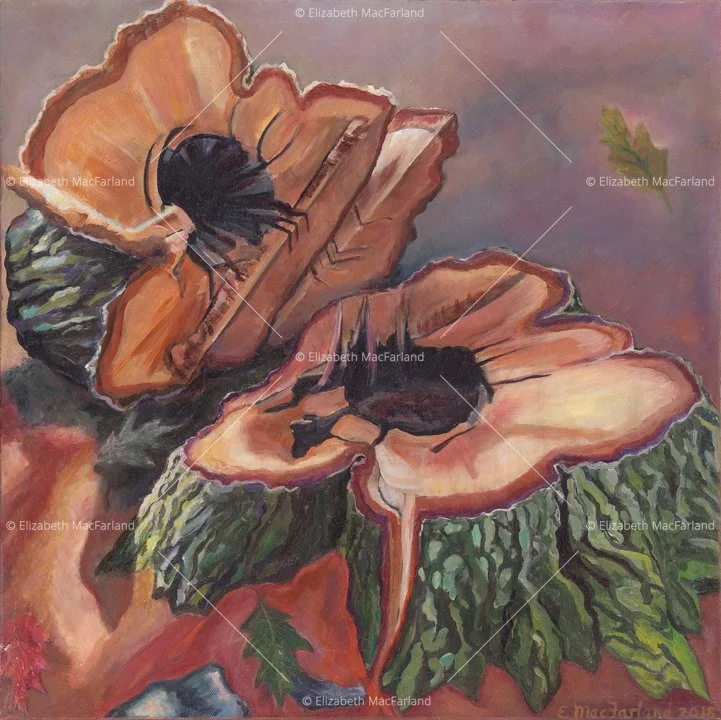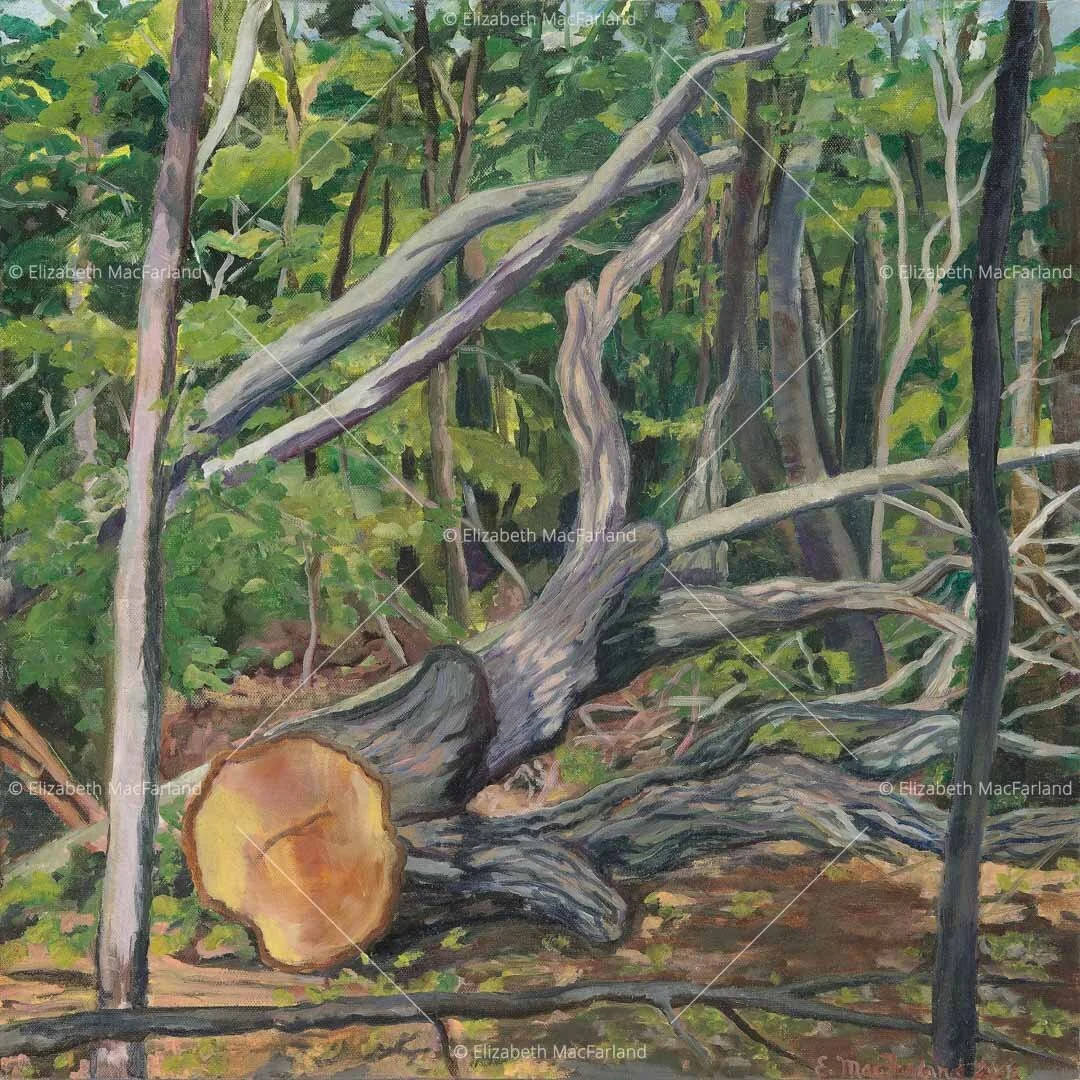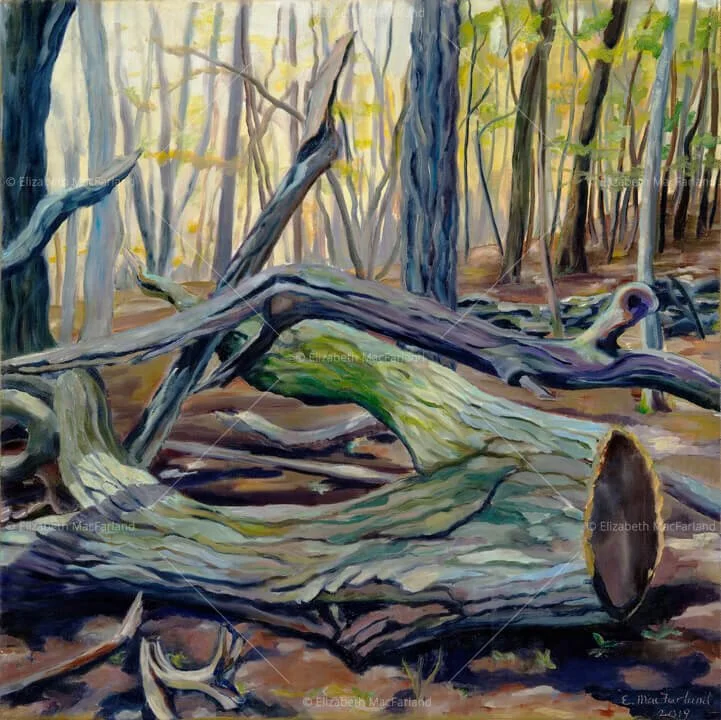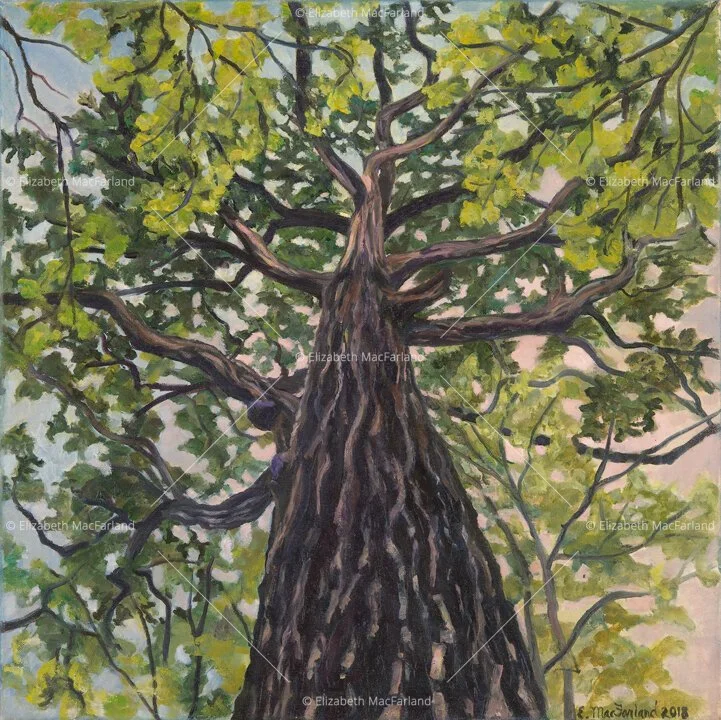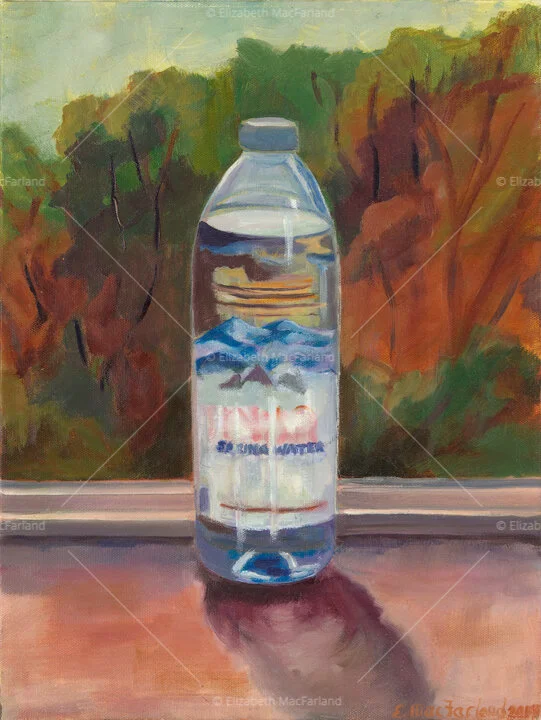Hostages of Dominion
This painting is an expression of the interdependence of life on earth, and the impact that we humans are now having upon it. All life currently on earth co-evolved to become the intricate, fragile circle we now know. Many earlier human societies recognized themselves as a part of nature, embedded and belonging within this circle. Only in more recent human history have we moved further and further from belonging within nature. Instead, we now mostly perceive ourselves as separate from, or above, the rest of creation. The tendency to dominate and use the natural world for our own purposes—- to “have dominion over” (Genesis 1:26) —-has been a part of modern human consciousness. Now the earth is in the midst of a climate emergency, and large numbers of extinctions are occurring through habitat loss, overhunting and fishing, and climate change itself. Because we too are part of nature, we too are ultimately threatened.
This painting arose from the recent stories in the news about legal cases being fought —-albeit so far unsuccessfully-—to grant personhood to certain animals, trees, and other threatened ecosystems. The idea of acknowledging other entities as “persons” that enjoy rights such as freedom, dignity, and protection from suffering or destruction resonated with me. We need to change our behavior if we are to survive.
The human figure in the painting is painted not only a threatening red, but also as a silhouette in order to appear symbolic of the current Anthropocene era in which humans have been the dominant influence on climate and the environment. The red lines extending from the figure, and surrounding all the creatures in the painting, show that nothing is untouched by humankind. The human figure, though appearing separate because of its red anonymity, is part of the intertwined fabric of nature. Although modern humans often live quite separately from the rest of nature, the truth is we all share a common planet and common destiny. The animals all have faces, and for the most part are looking out at the viewer. They are mostly untroubled, innocently unaware that they are actually “hostages of dominion.”
The circle symbolizes earth’s circle of life, and that circle’s need for unbroken continuity. Where one animal ends another begins, like pieces of a puzzle interlocking to make one whole. I also wanted to convey the idea that these creatures all have consciousness that is probably more like ours than not, and it’s mainly the bodily forms that take different shapes. It is as if a universal consciousness molds itself to become creatures of land, water, and sky. There is more commonality than difference. In fact, more studies are showing just how intelligent and complex non-human life is. It was as if, while I was painting, I could hear the animals saying, like the character in Shakespeare’s Merchant of Venice, “if you prick us do we not bleed?” The circle is also symbolic of our earthly home, spinning in space. I outlined the circle in red in order to depict a warming planet. We know the planet is warming primarily from human activity, jeopardizing all life. This is another way in which the creatures are innocent hostages of human activity.
While working on this painting I felt a deep empathy for all of life on earth. I hope we can find a new way of relating to our fellow travelers, human and non-human alike.
Hostages of Dominion
2022
Oil on canvas, 36” x 36”
Loss of the Mother Trees
“As he cut, the wildness of the world receded, the vast invisible web of filaments that connected human life to animals, trees to flesh and bones to grass shivered as each tree fell and one by one the web strands snapped.”
- Annie Proulx, Barkskins
Two years ago the sounds of chainsaws ripped through the silence: our neighbor was “harvesting” almost all of the majestic old oaks on a large swath of land behind ours. These were trees that started life before the civil war, with at least a 160 year ring count. Fortunately our neighbor was willing to spare a few of these beauties closest to our back property line.
I was in mourning when I ventured back to witness the destruction. Downed limbs were everywhere, and spring sap was rising up onto stumps with nowhere to go. I decided I wanted to chronicle their life and death by painting them, and headed back almost daily into the woods with brush and canvas.
I understand that taking trees for wood is as old as humanity. In this case, if it is business as usual, time will pass, and new oaks will grow, and grow old. I worry now, though, with changing temperature and rainfall patterns--in a climate that is rapidly changing--that this may be presumptuous. What will the next 160 years be bringing?
The mature trees in a forest are now referred to as “mother” trees because they protect and nurture neighboring trees through complex root systems which communicate. Mature trees are also the most efficient carbon sinks. This should give pause when considering modern day forestry practices.
The tree depicted in “Civil War Sapling” is one we saved, and we call her “Big Beauty”. We make daily sojourns to sit beneath her and are grateful she still stands. Humans have grown very accustomed to thinking of flora and fauna as existing for our own use, without enough thought given to the ramifications of our actions. There are other ways that flora and fauna benefit us, which we shouldn’t forget. When we sit beneath “Big Beauty” in stillness we can feel another dimension of belonging that whispers of our rightful place in the ecosystem.
Loss of Leaf and Limb
2018
Oil on canvas, 20” x 20”
Fallen Crown
2018
Oil on canvas, 20” x 20”
The Centuries Fell in a Day
2019
Oil on canvas, 20” x 20”
Ghost Limbs
2021
Oil on canvas, 20” x 20”
Old Tree
2015
Oil on canvas, 24" x 12"
Pushed to the Brink
2020
Oil on canvas, 12” x 48”
Windigo World
2019
Oil on canvas, 36” x 18”
My recent painting Windigo World arose from my subconscious as I looked at a thread of quartz in a large rock. The Windigo is a greedy and insatiably hungry cannibalistic creature in Native American mythology (Ojibwe, Cree, and Anishinaabe) that stalks humans in the deep cold of winter. It has become a symbol of greed and selfish disregard for the well-being of society and the earth. We have been treating the earth as if her resources are limitless, created just for human consumption. We have greedily consumed and consumed, like the hungry Windigo, and now we are reaping the consequences, as evidenced by the Climate Emergency we now face.
Water in Plastic
2020
Oil on canvas, 16” x 12”
Plastic in Water
2020
Oil on canvas, 16” x 12”
Mt. Pisgah State Forest
2019
Oil on canvas, 24” x 12”
And Then the Fires Came
2019
Oil on canvas, 24” x 12”
The Sorrow of Sophia
2009
Oil on canvas, 54" x 70"
ABOUT THE SORROW OF SOPHIA
Sophia, the Greek translation of the Hebrew “Hochmah” is the feminine personification of wisdom in the first five books of the Jewish Scriptures. She is neither a goddess nor a new age creation for feminist theologians. She was a real biblical divine being with more material on her in the Apocrypha than anyone in the scriptures, except, God, Job, Moses, and David.
She serves at the heart of the creative process, as Wisdom and as Teacher who was sent by God to save humanity.
The Book of Wisdom speaks to her divinity:
(7:25-26):
She is the breath of God’s power and a stream of pure glory of the Almighty. This is why nothing polluted enters her, For she mirrors God’s energy completely, and she images God’s goodness.
(6:12-13):
Wisdom is radiant and unfading, and she is easily discerned by those who love her, and is found by those who seek her, She hastens to make herself known to those who desire her.
And also speaks to the state of humankind without her:
(10:8):
For because they passed Wisdom by, they not only were hindered from recognizing the good, but also left for humankind a reminder of their folly, so that their failures could never go unnoticed.
In this painting, Wisdom, or Sophia, is the angelic figure emerging from the upper branches of the metaphorical Tree of Life. Her Sorrow is in response to the human and planetary crisis now emerging in our current age.
The Sorrow of Sophia was on loan at the Sanders Institute in Burlington VT in 2018.
On Thin Ice
2012
Oil on canvas, 24" x 72"
ABOUT “ON THIN ICE”
This painting depicts the planet earth caught up in a tidal wave of change. The concentric circles moving outward grow progressively warmer in color, as our planet is also growing progressively warmer. The lone Polar Bear in the foreground symbolizes the peril life may now be facing.


